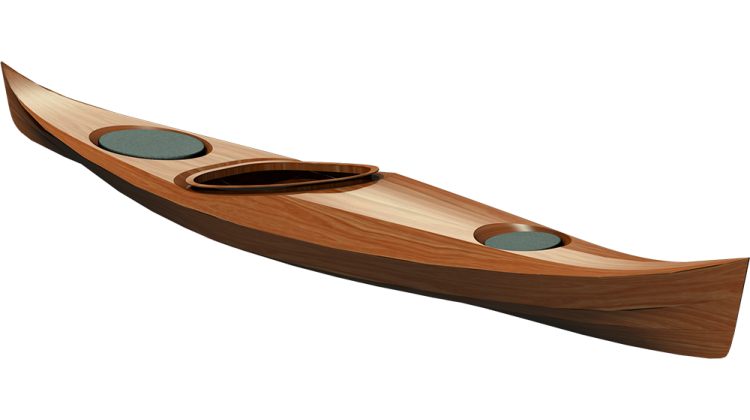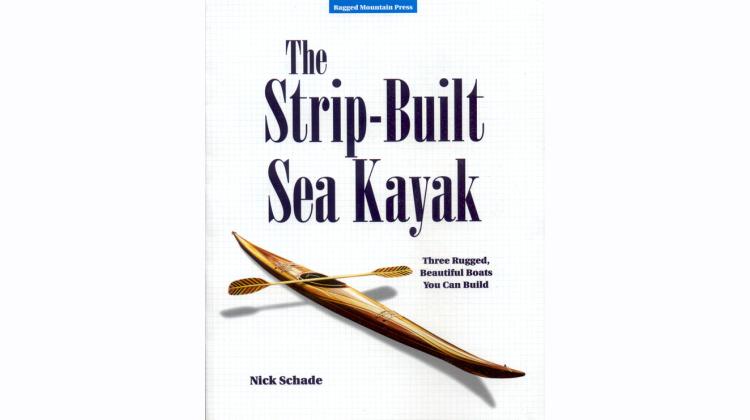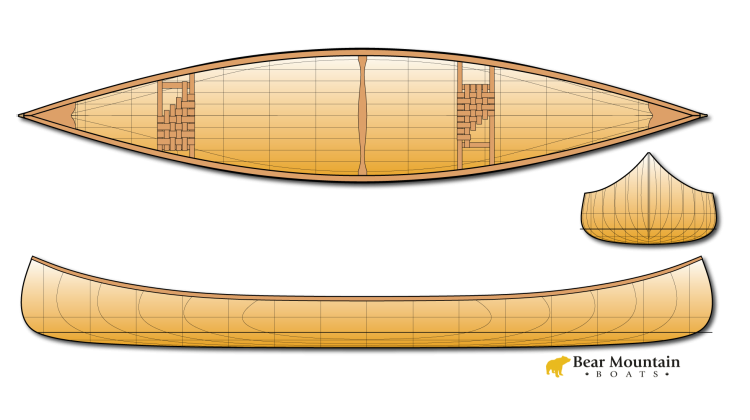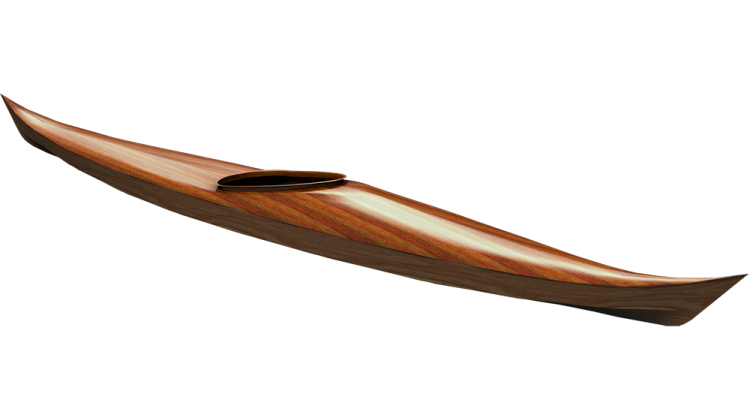Transcript
Hi I'm Nick Schade at Guillemot Kayaks, welcome episode number 18 of my series on making the strip built Petrel Play kayak.
In the previous episode I did the final prep work including fill coats and sanding. In this episode I'll varnish and varnish and varnish again.
As I said in the last episode, a fine finish depends on the prep work. I've sanding the kayak to a smooth and uniform surface with 220 grit sandpaper, now its time to start adding varnish.
The Petrel Play doesn't always have a distinct separation in the shape between the deck and the hull to make an obvious break point for varnishing. I did include a thin accent strip to highlight the transition.
I run a strip of masking tape just below the accent strip. This prevents drips from running down the side. While this will create a tiny ridge along the sheer, it will be camouflaged the accent strip.
Running a strip of masking tape is an underappreciated skill in itself. It takes practice to stretch a smooth, unbroken strip along a curved line. I hold one end stuck in place with my left hand, then pull out a length with my right hand, extending it down along of the feature line. As I press the tape down my left hand, I continue to steer with my right hand to keep the upper edge aligned with the accent strip. I use the stretchiness of the tape to allow it to follow the curved sheer.
Dust is a constant annoyance while varnishing. It is almost impossible to avoid having dust in your paint room if that the same space is also you mill room and sanding station. Diminish how much dust is floating around by keeping activity in your shop to a minimum in the days running up to varnishing.
Immediately before varnishing, wipe down your work surface with a tack cloth. A tack cloth is lint-free cheese cloth treated with a sticky wax material that dust adheres to.
I wipe the cloth over the surface, moving it in one direction so the dust I picked up at the front of the cloth doesn't get spread down again by making it the back of the cloth.
I keep the cloth folded, regularly refolding to expose a fresh, clean section.
One quart of varnish is usually enough to completely finish a kayak with three coats minimum.
I pour out enough for each section into a deep container. Dispensing through a filter will clean out any dust or dried bits that may be in the can.
My system for applying varnish is the same as I described for epoxy fill coats. I work on small sections at a time. The staple holes delimiting one foot sections are a good reference.
After saturating the brush I use heavy, horizontal or lengthwise strokes to get material out of the brush on to the boat.
This wet surface is then evened out with lighter, vertical strokes to smoothly distribute the finish.
Finally, more horizontal strokes with just the tip of the brush pop bubbles and flow out brushing lines.
Then I switch sides and repeat.
By hitting edges such as the stem and grab loop hole first I will brush out any drips created as I proceed.
I'll do two sections on this side before switching back to the other.
Varnish dries very quickly. If you try to extend a section that has already dried a bit you will leave a noticeable bump.
The phrase "Maintaining the wet edge" refers to the task of always extending areas while the previous section is still wet enough for the two sections to blend together smoothly.
This means you need to work fairly quickly and keep switching sides.
Again, the first pass on a section is about getting varnish out of the brush on to the boat. I press hard enough to squeeze the finish out of the foam.
The second pass is about distributing the varnish evenly. Moderate pressure on the brush helps move material from wet spots and apply it to dry spots.
The last pass is really about lifting up excess varnish. A light touch allows the foam to soak up thicker areas as it pops bubbles.
Here is a one foot section done in real time with no cuts. Since I am systematic about it, it takes about 17 seconds to do this section without being rushed.
This means that in about half a minute I am back to the other side where the edge is still wet.
Where I repeat the pattern of horizontal, vertical then horizontal strokes, move over one section and repeat again.
Varnishing is not the time to stop and answer the phone, or go eat a sandwich. The best results happen when you start and keep going until you are done.
When you get to a place where you have a sharp edge like this chine, it is good to think of either side of the edge as separate sections. When I perform my vertical leveling strokes, I do one section then the other to avoid creating drips. If I were to drag my brush across that edge it would scrape additional varnish out of the brush.
As soon as completed this varnishing session, I peel off the masking tape to let the edge relax a little.
Later the same day, the hull coat has dried sufficiently that I can flip the boat over and apply a coat to the deck.
I wipe the boat down with a tack cloth and apply masking tape to the sheer line. I probably should have waited with the tack rag until after taping, but in these early coats it isn't that critical. Think of this as practice.
The trickiest, most time consuming areas to varnish are those with a lot of details and contours like around the cockpit. I address these areas first so I won't lose my wet edges as I move past them later.
I cut down a foam brush to make it easier to reach under the coaming.
Like at the chines, I try to avoid scraping my brush across sharp edges which releases more varnish. Instead I stroke parallel to the edges and come back after to mop up any excess.
Unlike what I'm doing here, it can help to work from the inside out, so you don't end up leaning over sticky wet varnish.
I'm working all the way out to the edge of the recess, so when I pass this way again working on the body of the deck, my transition from wet to dry occurs at the sharp edge so any build up is hard to detect.
Getting finish into these recessed fittings is a bit frustrating. I made a little brush out of the bits I cut of the one for the coaming glued to a stick.
I start by forcing the brush into all the nooks and crannies and then using a lighter touch to soak up the thicker drips.
Once the details are dealt with, it is back to systematically working from one end to the other in one foot sections at a time.
Where I can practically reach over the whole boat, I'll do the whole width at once.
As the boat gets wider, I revert to working on half at a time.
I like a deep container for my varnish because I'm less likely to spill. I will also slap off excess on the inside instead of scraping the brush across the top.
On the final, light lengthwise pass I always stroke from dry towards wet. Landing the brush into a wet area will soak up some material and may leave a mark.
I over brush from one side on to the other to blend the sections together. My final tipping pass extends beyond the newest section into the prior sections.
While working over the fittings, I pay attention to make sure I don't slop a blob into the recess that will result in a sag later.
I often forget about separate parts like the hatch cover. I stick a loop of tape to the bottom to make it easier to hold.
Again I start with the details like these stand-off blocks and the edges before brushing out the body of the part.
Working around the fiddly bits as best I can I first apply the varnish, then level it out, and tip it off.
Even if your first coat looks perfect, one coat of varnish is not enough. It is important to remember why we are varnishing in the first place. Ultra Violet breaks down epoxy. Varnish protects the epoxy from UV.
We need more than one coat to get good protection. For the next coat to stick well we want to rough up the surface of the prior coat. We could sand the surface, but this can remove a lot of the varnish. I like to use abrasive scouring pads like a Scotch-Brite to degloss the surface. It does not remove as much of the protective varnish while giving it good tooth for the next coat.
The scouring leaves some dust which I vacuum off and then follow up with a tack cloth.
Once again, I tape off at the sheerline. I always run the masking tape below the accent strip so I get overlap between the hull and deck coats.
The final appearance of your varnish is primarily a function of how well you do the last coat. This means that a few mistakes in these early coats probably won't mess up the looks of the finished boat, but take these early coats as an opportunity to practice.
My typical work day while varnishing is to degloss everything in the morning, and then varnish the hull immediately. After dinner I come back into the shop and varnish the deck.
The same ritual every time, tack cloth, masking, work on the details, coat the body of the deck, then hit the hatch cover.
The purpose of deglossing is to give the existing varnish some tooth so the next coat will stick well. With these first few coats I am trying to build up some thickness with the varnish. The abrasive scouring pad doesn't really remove much material, and it doesn't level drips or remove dust picks. It just roughens the surface enough so new varnish will stick.
As I add more coats I start thinking more about dust. Here I give the boat a mineral spirits wipe down to remove the deglossing dust.
The number of coats of varnish required is a bit arbitrary, but I would say you want a minimum of three. This should be enough to protect a kayak that gets moderate use for several years. However, more varnish is more protection. And a thick layer can give the finish depth that looks really nice.
But, there are limits. Personally, I start get bored of this sanding and wiping and taping and brushing, peeling, and taping, wiping, and brushing and sanding and wiping and taping and brushing, peeling and
And eventually it all has to stop. But so far, I'm doing OK, I hope you aren't too bored yet.
After three coats, the surface has started to accumulate some bumps and drips. To help level out the finish I'm switching to sandpaper instead of the scouring pad. Sandpaper more aggressively cuts off the high spots to return it to a smooth surface.
With three coats under your belt, you will probably have the drill down pretty well. Being systematic with your process should help you obtain a consistent smooth and glossy film of varnish over the whole kayak.
This will be my final sanding before for the last coat of varnish. I'm wet sanding because it does not gum up the sandpaper quite as quickly and it the water lubricates the surface to help cut faster. It is a bit messy so I don't use water all the time.
Apparently, using a spray bottle of water like this is actually called "damp" sanding instead of wet, but the principle is the same and its easier than having a hose running in my shop.
Like power sanding the epoxy in previous episodes, I'm not touching corners with the hard block. I hold the block flat against the large surfaces so I don't burn through the varnish. The fine corners will be touched up later.
The water beads up when it first hits the varnish. As the surface gets scratched up the beads disappear.
Wipe off the sanding sludge as you go so you can inspect your work. The gunk can be really quite tenacious if you let it dry, so try to keep after it.
If you see any shiny spots, spray on more water and resand the area.
When the boat is all sanded out, I wipe it down with water.
After the water has evaporated, I go over it again with mineral spirits to assure there is no residual moisture.
This time I use a polypropylene fine line masking tape which is thinner than standard tape and leaves less of a ridge at the edge.
The camera stopped while I was finishing the hull, but you are getting bored and don't want to watch that anyway.
So, I'll make you watch the deck. The process is the same systematic, left-right, up-down, left right, move to the next section work you've been watching for the last 15 minutes. After 5 coats you should be pretty good at it.
In the next episode I'll be fitting out the kayak making it ready for use.
As this series is winding down I hope you are learning a lot about how to make a strip built kayak. There is always more information I have to share, if you would like to see other builds in the future please let me know. The easiest feedback you can give me is to hit subscribe, like this video and share it with your friends.
Until the next episode, thanks for watching and happy paddling.






